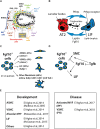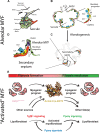Role of Fibroblast Growth Factor 10 in Mesenchymal Cell Differentiation During Lung Development and Disease
- PMID: 30487814
- PMCID: PMC6246629
- DOI: 10.3389/fgene.2018.00545
Role of Fibroblast Growth Factor 10 in Mesenchymal Cell Differentiation During Lung Development and Disease
Abstract
During organogenesis and pathogenesis, fibroblast growth factor 10 (Fgf10) regulates mesenchymal cell differentiation in the lung. Different cell types reside in the developing lung mesenchyme. Lineage tracing in vivo was used to characterize these cells during development and disease. Fgf10-positive cells in the early lung mesenchyme differentiate into multiple lineages including smooth muscle cells (SMCs), lipofibroblasts (LIFs) as well as other cells, which still remain to be characterized. Fgf10 signaling has been reported to act both in an autocrine and paracrine fashion. Autocrine Fgf10 signaling is important for the differentiation of LIF progenitors. Interestingly, autocrine Fgf10 signaling also controls the differentiation of pre-adipocytes into mature adipocytes. As the mechanism of action of Fgf10 on adipocyte differentiation via the activation of peroxisome proliferator-activated receptor gamma (Pparγ) signaling is quite well established, this knowledge could be instrumental for identifying drugs capable of sustaining LIF differentiation in the context of lung injury. We propose that enhanced LIF differentiation could be associated with improved repair. On the other hand, paracrine signaling is considered to be critical for the differentiation of alveolar epithelial progenitors during development as well as for the maintenance of the alveolar type 2 (AT2) stem cells during homeostasis. Alveolar myofibroblasts (MYFs), which are another type of mesenchymal cells critical for the process of alveologenesis (the last phase of lung development) express high levels of Fgf10 and are also dependent for their formation on Fgf signaling. The characterization of the progenitors of alveolar MYFs as well the mechanisms involved in their differentiation is paramount as these cells are considered to be critical for lung regeneration. Finally, lineage tracing in the context of lung fibrosis demonstrated a reversible differentiation from LIF to "activated" MYF during fibrosis formation and resolution. FGF10 expression in the lungs of idiopathic pulmonary fibrosis (IPF) vs. donors as well as progressive vs. stable IPF patients supports our conclusion that FGF10 deficiency could be causative for IPF progression. The therapeutic application of recombinant human FGF10 is therefore very promising.
Keywords: Fgf10; alveolar myofibroblasts; fibrosis; lipofibroblasts; lung.
Figures


Similar articles
-
Highlighting fibroblast plasticity in lung fibrosis: the WI-38 cell line as a model for investigating the myofibroblast and lipofibroblast switch.Theranostics. 2024 Jun 11;14(9):3603-3622. doi: 10.7150/thno.93519. eCollection 2024. Theranostics. 2024. PMID: 38948058 Free PMC article.
-
Fgf10 Signaling in Lung Development, Homeostasis, Disease, and Repair After Injury.Front Genet. 2018 Sep 25;9:418. doi: 10.3389/fgene.2018.00418. eCollection 2018. Front Genet. 2018. PMID: 30319693 Free PMC article. Review.
-
Use of the Reversible Myogenic to Lipogenic Transdifferentiation Switch for the Design of Pre-clinical Drug Screening in Idiopathic Pulmonary Fibrosis.Front Bioeng Biotechnol. 2020 Sep 15;8:569865. doi: 10.3389/fbioe.2020.569865. eCollection 2020. Front Bioeng Biotechnol. 2020. PMID: 33042971 Free PMC article. Review.
-
Fgf10-positive cells represent a progenitor cell population during lung development and postnatally.Development. 2014 Jan;141(2):296-306. doi: 10.1242/dev.099747. Epub 2013 Dec 18. Development. 2014. PMID: 24353064 Free PMC article.
-
Origin and characterization of alpha smooth muscle actin-positive cells during murine lung development.Stem Cells. 2017 Jun;35(6):1566-1578. doi: 10.1002/stem.2615. Epub 2017 Apr 3. Stem Cells. 2017. PMID: 28370670
Cited by
-
FGF10 mediates protective anti-oxidative effects in particulate matter-induced lung injury through Nrf2 and NF-κB signaling.Ann Transl Med. 2022 Nov;10(22):1203. doi: 10.21037/atm-22-4389. Ann Transl Med. 2022. PMID: 36544647 Free PMC article.
-
Boosting RNA nanotherapeutics with V-ATPase activating non-inflammatory lipid nanoparticles to treat chronic lung injury.Nat Commun. 2025 Jul 14;16(1):6477. doi: 10.1038/s41467-025-61688-z. Nat Commun. 2025. PMID: 40659631 Free PMC article.
-
Mesenchymal WNT-5A/5B Signaling Represses Lung Alveolar Epithelial Progenitors.Cells. 2019 Sep 25;8(10):1147. doi: 10.3390/cells8101147. Cells. 2019. PMID: 31557955 Free PMC article.
-
Fibroblast growth factor 10 protects against particulate matter-induced airway inflammatory response through regulating inflammatory signaling and apoptosis.Am J Transl Res. 2019 Nov 15;11(11):6977-6988. eCollection 2019. Am J Transl Res. 2019. PMID: 31814901 Free PMC article.
-
Ectopic and visceral fat deposition in aging, obesity, and idiopathic pulmonary fibrosis: an interconnected role.Lipids Health Dis. 2023 Nov 24;22(1):201. doi: 10.1186/s12944-023-01964-3. Lipids Health Dis. 2023. PMID: 38001499 Free PMC article. Review.
References
-
- Bellusci S., Grindley J., Emoto H., Itoh N., Hogan B. L. (1997). Fibroblast growth factor 10 (FGF10) and branching morphogenesis in the embryonic mouse lung. Development 124 4867–4878. - PubMed
LinkOut - more resources
Full Text Sources
Other Literature Sources
Research Materials

